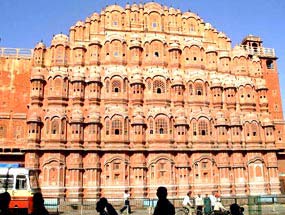Hawa Mahal of Jaipur is one of the most popular
tourist attractions of Rajasthan. Read about Hawa Mahal of Jaipur,
India.
Hawa Mahal

Location: Jaipur, Rajasthan
Founded By: Maharaja Sawai Pratap Singh
Founded In: 1799
Architect: Mr. Lal Chand Usta
Hawa Mahal is a magnificent building situated in the 'Pink City' of
Jaipur. A multi-layered monument, it dates back to the year 1799. The
palace was built under the patronage of Sawai Pratap Singh, the grand
son of Sawai Jai Singh and son of Sawai Madhoo Singh. Mr. Lal Chand Usta
was selected as the architect of the splendid Hawa Mahal. The structure
of the palace looks quite similar to a beehive. It has been constructed
out of red and pink sand stone, which have been meticulously outlined
with white borders and motifs.
The palace stands overlooking one of the main streets of Jaipur. It was
initially intended to serve as the place from where women of the court
could watch the activities taking place in the bazaar and the
surrounding streets, from the comfort of stone-carved screens. Hawa
Mahal has over 900 niches and has been built in the shape of the crown
that adorns Lord Krishna's head. The palace has five stories and is
ornamented with small casements, each of them having tiny windows and
arched roofs.
The inner face of the palace as well as the chambers is quite plain and
lacks any ornamentation. The entry of the palace is from its rear,
rather than its front portion. A majestic door provides the entry to the
palace and the first structure that one comes across is a spacious
courtyard. Surrounding the courtyard on three sides is a double-storied
building. The building houses an archaeological museum inside its
premises. Only the eastern wing of the Hawa Mahal has three more stories
above.
Hawa Mahal stands on top of a high podium and rises to a height of
fifty feet. The thickness of the palace is even less than a foot and it
comprises of a number of small personal chambers. Instead of regular
stairs, there are ramps reaching the upper floors. As one looks up from
the roadside, Hawa Mahal comes across as a delicate screen with its
numerous casements. Little lattice worked windows, small balconies and
arched roofs, with hanging cornices, make the palace definitely worth a
visit.


